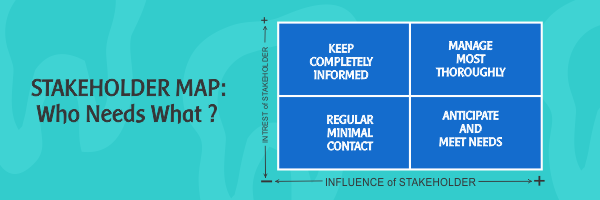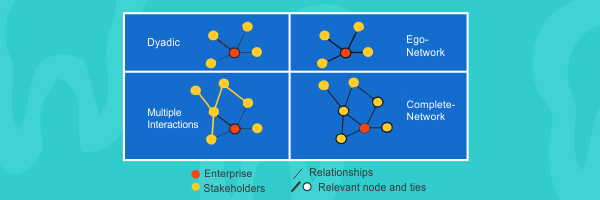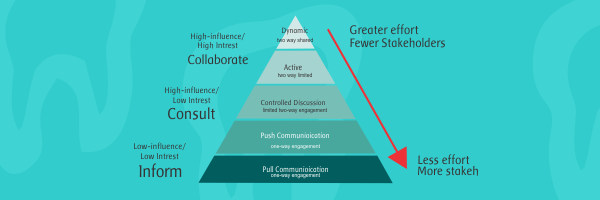
The stakeholders network effect?
Sometimes sudden changes in state or local policies or economic crises lead managers to manage their stakeholder network for the greater good of the company.

Unprecedented political and power changes at the local, state, and federal levels pose challenges for executives and government professionals whose mission is to strengthen the organization's stakeholder network.
Building relationships with influential people through years of effort is still the basis for dealing with government influences, but it is no longer sufficient. You need to be able to see and manage how all stakeholders (internal team members, the general public, government, or other organizations) intersect.
A stakeholder management system that allows you to monitor everything from one place to connect points, build networks, and manage problems with rapidly changing political conditions, partisan legislators, and even public perceptions.
What is a stakeholder network?
Responding to stakeholders may be tough, and it might feel like there are competing interests at times. However, how you add value to your colleagues is determined by how you add value to your organization's members. It is about determining how to provide value for the general public, allies, and other stakeholders.
They must harmonize their interests. In music, the notes are different, but they sound together. It is a mistake to consider each stakeholder to be independent and that one requirement is more important than the other, or that one's interests need to be weighed against the other's interests. And the way to avoid this mistake is through communication.
Managing stakeholder networks means maintaining open communication and using your imagination to align all interests towards a common goal. You may need to balance the needs of one group and another to reach your goals. But if you don't look for it, you can't find it.
When making a series of compromises, take only shortcuts. You are not doing the creative work you need to do.
The network approach in stakeholder management theory
While networking is an important feature of stakeholder management, big contributions seldom go beyond emphasizing the company's tough relationships with each partner. Since the early studies on stakeholder management theory, stakeholders have been seen to be interconnected and affect each other as network actors.
Stakeholder mapping and stakeholder dashboards, for example, were highlighted by Freeman (1984) as tools for managers to analyze the demands of various stakeholders. Which the firm is affiliated with, and which aids managers in understanding the ties that connect them all. The best way to leverage networks and their architecture in stakeholder management is still up for dispute.
There are several techniques, ranging from the traditional approach, which requires managers to concentrate on notable stakeholders, to broader viewpoints, which require managers to evaluate the same stakeholder network structure.

We divided the diverse methods of stakeholder management into two categories based on two different elements of the interactions.
- The first factor we considered was whether the author asked managers to consider stakeholders who were not directly related to the enterprise
- The second factor we considered was whether the authors asked managers to evaluate each stakeholder in a one-to-one relationship with the enterprise or if they were asked to manage the network as a whole.
The dyadic relational approach:
This strategy contains models that demand managers to concentrate on the most important stakeholders to assist the organization to accomplish its objectives. The relationship with these stakeholders is seen as a challenging relationship that is unaffected by the other node's relationships.
These studies realize that organizations may face competing requests from many stakeholders and seek to equip managers with various tools to help them identify and pick the most appropriate and effective tactics to deal with each group.
The Ego-network approach:
In this technique, we've gathered studies on the competing requirements of stakeholders. They instruct managers to focus on the requirements of the complete network of actors with whom they are working rather than on individual players before developing their strategy; these studies encourage managers to focus on their entire ego network.
This position, as demonstrated by Freeman et al. (2010), is founded on one of the key concepts of Stakeholder Management: the necessity for managers to analyze the demands of various stakeholders without participating in inter-stakeholder arbitration.
When Donaldson and Preston (1995) understood that the theory required managers to examine all valid requirements at the same time, they used this perspective in their management thesis on stakeholder management. Stakeholders can be seen as a system if they are seen as such.
According to Clarkson (1995), the strategy of considering stakeholders' requirements is more compatible with managers' real behavior than the prior approach, because his 10-year study project stressed that managers respond to stakeholder concerns rather than individual stakeholders.
Because certain issues are connected to more than one class of stakeholders, this strategy should be better equipped to respond to the real demands of managing stakeholders, as some concerns are more prominent than what could be comprehended using the prior perspective.
The Multi-Interaction method:
This third method includes research that challenges managers to consider not just the stakeholders with whom their businesses are associated, but also the relationships among them.
This stakeholder management strategy is based on a more realistic understanding of the company's connection with its stakeholders. The company is considered as part of a bigger environment of actors made up of a variety of actors engaging on a variety of levels with one another and with the company.
The complete Network Approach:
The fourth method focuses on the importance of stakeholder network structure in determining which stakeholder problems to prioritize. This technique was first proposed by Freeman (1984), who advised that managers use agent maps to depict indirect linkages among themselves and urge them to comprehend how specific triggers might affect others.
The network's structure depicts the stakeholders' indirect influence channels that the power will use to affect the company's behavior. Freeman defines indirect influence routes as tactics that a stakeholder can employ to manipulate source flows to influence another organization with which it has no relationship. By using 'an ally,' you can force the corporation to do what it needs to do.
To obtain control over the network, these tactics might rely on both access to specific resources and the network's location.
The perspectives of stakeholders can be influenced by network structure in two ways. The more often stakeholders connect, the simpler it is for them to communicate behavioral expectations, resulting in their goals being more aligned and putting more pressure on the company. The more tightly organizations are linked, the more they may control information and resource flow, increasing their influence in the network.
To fully comprehend how stakeholders' interactions might affect the business, managers should focus on the network defined by the enterprise's stakeholders and the relative web of relationships. Knowing the structure of a network may be beneficial in two ways.
On the one hand, it identifies its indirect stakeholders or people who can impact the organization without having a direct relationship with it, as well as how these influences appear. Going beyond the enterprise ego network to reflect the stakeholders' whole network, on the other hand, will allow managers to abandon the previous three classes' enterprise-centric approach.
What Are Some Strategies for Creating a Stakeholder Network?

Know who owns what:
The first step may appear apparent, yet it is frequently overlooked. The purpose is to understand each stakeholder's requirements and aspirations, not to make a list of them. It's about figuring out how all of their objectives are linked and how you can align them to develop relationships and communicate more effectively to reach consensus and commitment.
You may see vote records, ideological viewpoints, and committee representation using stakeholder management technologies. Your team may begin to generate an accurate map of the same vote representation across party lines from the federal government to the local level using these data points. The goal of stakeholder management is to expand your network by making data-driven decisions.
Data should be used to find new champions:
Because the majority of legislation is passed at the state level, recruiting new co-sponsors becomes increasingly vital if you want to be recognized and prioritized on the agenda. Stakeholder management tactics implemented by modern government and public relations teams rely on what data transmits to them rather than closed-door negotiations.
Teams can subsequently uncover additional support for the policy's cause by employing technology to find out what authorities and lawmakers have done in the past.
Stakeholder management software analyses public comments on federal rules and monitors social media activity to ensure that teams are on the same page concerning regulations. You can see who is sharing with you.
This knowledge may aid in the identification of new supporters, the formation of coalitions with important stakeholders, and the pursuit of particular objectives. Teams may see input from rivals, advocates, customers, and like-minded enterprises through regulatory analysis in a way that was previously only possible through human encounters and connections.
Using a single recording system to collaborate:
The rationale behind managing the stakeholder network is that notes, information about employee communication, contacts, and team and member working connection networks should not be kept in separate files or spreadsheets. Instead, the team should consolidate this confidential knowledge into a single source of truth.
Teams should make developing workspaces a top priority to concentrate operations, obtain access to information, and get a 360-degree picture of all challenges affecting the company. You may build multi-directional communication and collaboration with non-governmental and non-public teams by establishing this unified recording system.
When everyone has access to the same dashboard and workplace, communication is effortless. As a result, whether a team member departs or is promoted, the organization's working networks and ties are preserved.
Collaboration across teams and departments is made easier by maintaining a shared knowledge system through relationships. Employees from outside the government department can also provide information about external ties to help the network grow.
This will reveal who is interacting with whom, how to leverage them, the best approach to engage them to achieve your objectives, and what you can expect from this business connection. The door to learning has been opened.
The regular conversation will leave an indelible impression on your heart:
By employing regular communication that connects your work to their challenges, you may be remembered by stakeholders and viewed as a partner. The key to building an effective communication strategy is to plan ahead of time.
Create effective and focused messages that attract your stakeholder network, discover common challenges and preferred channels of communication, and map out your stakeholder network. You may tag stakeholders based on their interests and concerns, and send targeted messages to particular groups using the stakeholder management platform.
You may keep more than simply contact information on the stakeholder management platform. You may also preserve meeting notes, problems, confidential information, and other information to provide individual stakeholders with a thorough and systematic understanding of the many papers and their ramifications. This enables teams to keep informed about the activities of the stakeholder network and improve communication with all stakeholders.
Pinpoint the right indicators and investments:
Effective advocacy and lobbying are all about building and maintaining networks that you and your organization can rely on. It might be tough to persuade the C-suite and the board that investing in a network is worthwhile.
One of the most significant advantages of implementing a technology-driven stakeholder management approach is that teams can report back and forth on the action's return on investment. A stakeholder management tool enables you to focus on what matters most to your team or business, and priorities the correct indications in a language that the board can understand.
The team will look at which networks have been most effective, where advocacy and lobbying have been most successful, who the most powerful and productive stakeholders are, and how advocacy and lobbying have affected direct budgets. It is possible to determine.
Organizations may measure and quantify what was previously immeasurable and provide accurate and thorough reports on their efforts to bring value to their company or business by employing a stakeholder management approach.
Follow the project:
Maintaining stakeholder confidence and proving stakeholder commitment to goals through the implementation of joint initiatives and plans. Communication is crucial in stakeholder management once again. Always keep stakeholders informed of any advances, challenges, or difficulties you encounter on your route to attaining a certain objective.
Maintain the relationship:
Think about what it takes to get to know Congressmen and build a lasting relationship. Stakeholder management is a labor-intensive, long-term activity. The ability to manage all stakeholder relationships and networks maintained by an organization in one place and facilitating collaboration between departments is key to effective stakeholder management.
With Stakeholder Management platforms, teams log actions and link them directly to bills, regulations, legislators, and committees to see what happens and what the concrete results are. You can track it. In the meantime, collaboration tools allow you to collect and share these actions and results within and between organizations. In addition, the analysis can tell you what you didn't know about existing relationships and dig deeper into the trends of superficial parliamentarians who need to build stronger relationships.
Conclusion
Managers must determine how to allocate resources, such as attention and prestige, to different stakeholders to change the structure of connections within a larger social network to achieve corporate success.
If these tactics improve communication, trust, norms, understanding, and agreement building between identity groups, they can facilitate group consensus and lower the likelihood of conflict.
Managers who need to connect sub-components in larger social networks that have weak linkages (structural holes) utilize so-called "useful brokers" in conflict-affected regions. Frequently minimizes the likelihood of a disagreement. These brokers produce value in the system based on their economic, political, and/or social positions.
They can facilitate information transfers, establish a welcoming environment for friendly or neutral encounters, and/or give incentives to encourage collaborative activity.
These brokers are network subcomponents, and their members are involved in ongoing fights, although each subcomponent may have some embedding among its members. It gives a certain level of trustworthiness and dependability.
Managers attempting to overcome structural gaps have the option of portraying themselves as independent mediators or mediators between the parties or collaborating with local mediators who can assist them.
The former technique may appear to be more straightforward. It helps the corporation to establish its social capital, focus its agenda on pressing commercial challenges, and maintain control over procedures and outcomes.
However, in a larger social network, this method might be highly difficult. Companies that assist brokers can be difficult to discover in the community, but they are typically informal yet adequate to maintain an acceptable degree of cooperation despite the stress of the war.
At a practical level, managers in conflict-affected areas are encouraged to focus their stakeholder relationship strategies on:
- Convenient network subcomponent
- Bridge members of different identity groups
- Resolve obstacles in your company's stakeholder network
- Leverage broker support to help you in a wider community network.
In the absence of these targeted interaction techniques, firms' income tends to be negatively impacted by increased unhappiness and alienation of specific identity group members, fostering conflict rather than harmony on a societal level.
Investors, creditors, and philanthropists who want to address the enormous societal concerns of climate risk, racial and migratory justice, human rights, and inequality would gain from this method of constructing linked networks.
As a result, growing a company's stakeholder network allows it to connect with more individuals at more network nodes, therefore strengthening or weakening stakeholder relationships amongst identity groups.